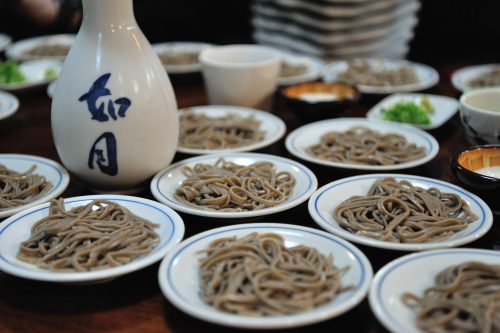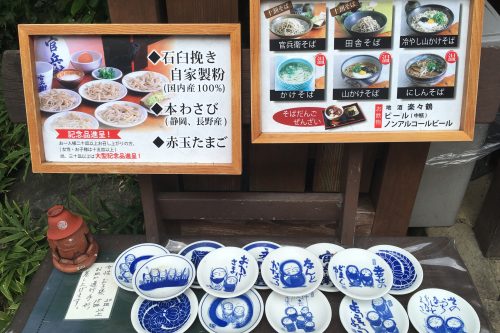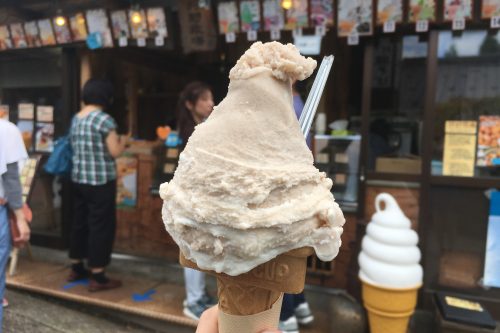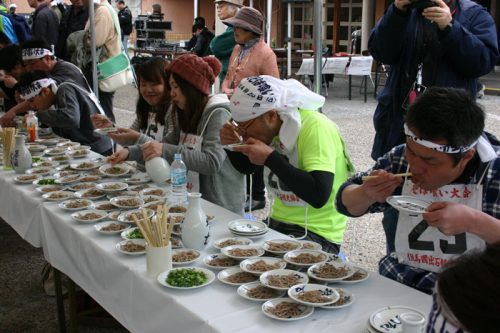【Press Release】Izushi Sara Soba
Izushi, a castle town less than an hour from Kinosaki Onsen, is home to many Edo-era relics and museums, but also has a delicious local specialty—Izushi Sara Soba.
- Izushi Sara Soba and condiments
- Izushiyaki outside one of the many local soba shops
- Soba ice cream, available at various shops in town
- Competitors eating their weight at the annual soba-eating tournament
Various types of soba noodles, which are made of buckwheat, can be seen and eaten all over Japan. However, Izushi Sara Soba stands out from other styles due to its unique presentation. While soba in Japan is usually served in a large dish, Izushi Sara Soba is served in small portions on small plates, or sara. At a soba noodle shop, the standard serving size of Izushi Sara Soba is five plates. Thus, when going out to eat with friends or family, the table is topped with an impressive mountain of tiny dishes. There are about 50 such shops in Izushi.
In 1706, during the Edo era, the daimyo (feudal lord) of the Matsudaira clan in Izushi switched territories with the daimyo of the Sengoku clan in Ueda. This new Izushi daimyo, named Sengoku Masaakira, brought with him soba-making techniques from a local artisan to add to pre-existing methods. It is said that the unique presentation of Izushi soba began at the end of the Edo era (late 1800s) when it was found convenient to serve soba on small dishes at food stalls.
After that, the town started producing Izushiyaki, Izushi-made pottery known for its simple white and blue designs. Each soba shop has its own unique Izushiyaki, and patrons can see the striking designs once they finish each plate.
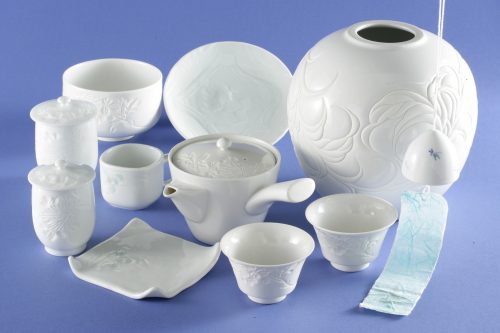
Izushiyaki, pottery designated a traditional craft by the Ministry of Economy, Trade and Industry
Izushi soba is served cold and dipped in a chilled Japanese soup stock called dashi that has been mixed with other toppings such as green onions, grated yam, raw egg, and wasabi. In order to fully enjoy the flavor of the soba noodles, it is encouraged to eat the first plate by itself, followed by a plate of just noodles with dashi, and finally finishing the last plates with any toppings one prefers. At the end of the meal, the leftover dashi is mixed with hot water for guests to enjoy a warm, hearty soup.
Aside from soba noodles, Izushi sells some delicious soba-flavored desserts, including ice cream, warabi mochi (a jelly-like confection), pudding, and tea. Although it may sound unusual, the soba-flavored ice cream has a delightfully subtle taste and creamy texture.
In addition to sitting down at a shop and eating soba with dashi broth and various condiments, one can also participate in a food challenge. Many of the soba shops in Izushi offer a prize in the form of a commemorative wooden plaque for those who eat 20 plates of Izushi Sara Soba in one sitting. There is even an annual soba-eating tournament held in April. The record is 153 plates in 10 minutes, conquered by a woman in 2008. Are you up to the challenge?
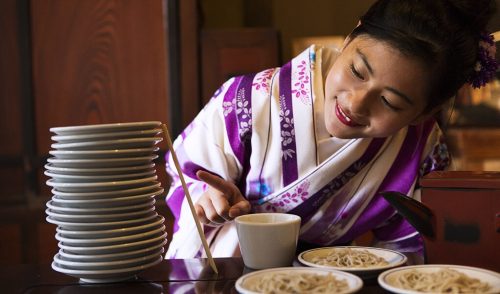
20 stacked plates reach the height of a pair of chopsticks!
Visitors can even try making soba from scratch! Starting from freshly-ground buckwheat flour, participants mix the dough with water and knead, stretch, fold, cut, and boil it with the help of an artisan. Participants can then enjoy their freshly-made soba with any traditional toppings.
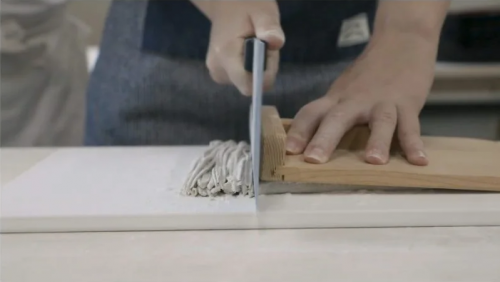
Cutting freshly-kneaded soba dough to later boil
Visitors may purchase a coupon to try Izushi Sara Soba at three shops of their choosing. Each purchase comes with three replicas of Eiraku Tsuho, a coin used in Japan in the late 1500s, which patrons can exchange for orders of soba.

